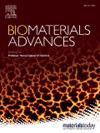多功能木质素-阿拉伯胶纳米复合材料:通过超声波辅助漆酶催化的绿色纳米结构,用于抗菌、抗氧化和抗糖尿病治疗
IF 6
2区 医学
Q2 MATERIALS SCIENCE, BIOMATERIALS
Materials Science & Engineering C-Materials for Biological Applications
Pub Date : 2025-06-16
DOI:10.1016/j.bioadv.2025.214390
引用次数: 0
摘要
利用天然材料的纳米技术为治疗进步提供了可持续和具有成本效益的解决方案。木质素和阿拉伯胶(GA)作为具有生物相容性的天然聚合物,具有显著的生物活性;然而,它们在纳米复合材料形式下的协同潜力仍未得到充分开发。本研究采用超声波辅助漆酶催化的绿色合成方法合成并表征了木质素- ga纳米复合材料(LGA-NPs)。所得纳米复合材料的平均尺寸为67±18.9 nm, zeta电位为−32±0.3 mV。通过XRD, FTIR和XPS的结构分析证实了酶氧化偶联和超声波处理导致的新官能团的引入和氧官能团的增强。LGA-NPs对金黄色葡萄球菌和白色念珠菌的MIC值为156 μg/mL,对大肠杆菌的MIC值为312 μg/mL,明显优于木质素、GA和木质素纳米颗粒。机制研究表明LGA-NPs与微生物表面相互作用,破坏膜,抑制呼吸链,产生ROS,降低ATP和代谢活性,最终损害微生物生长。抗氧化评价显示具有较强的自由基清除活性(IC50为50 μg/mL), α-淀粉酶抑制实验证实具有抗糖尿病潜力(IC50为75.0 μg/mL)。溶血试验显示生物相容性,溶血率低于5%,反映了生物医学应用的安全性。GA掺入木质素中,不仅提高了木质素的生物活性,而且增强了木质素的安全性,强调复合物质形成的协同效应。这些纳米复合材料提供了一种新的、可持续的、经济上可行的治疗平台,可以解决复杂的疾病,如糖尿病脓毒性足,需要有效的血糖控制、强大的抗菌作用和强大的抗氧化能力。本文章由计算机程序翻译,如有差异,请以英文原文为准。

Multifunctional lignin-gum Arabic nanocomposites: Green nanoarchitectonics via ultrasonic-assisted laccase catalysis for antimicrobial, antioxidant, and antidiabetic therapies
Nanotechnology leveraging natural materials offers sustainable and cost-effective solutions for therapeutic advancements. Lignin and gum Arabic (GA), as biocompatible natural polymers, possess significant bioactive properties; however, their synergistic potential in nanocomposite form remains underexplored. This study synthesized and characterized Lignin-GA nanocomposites (LGA-NPs) through ultrasonic-assisted laccase catalysis, a green synthesis method. The resulting nanocomposites exhibited an average size of 67 ± 18.9 nm and a zeta potential of −32 ± 0.3 mV. Structural analysis via XRD, FTIR, and XPS confirmed the introduction of new functional groups and enhanced oxygen functionalities driven by enzymatic oxidative coupling and ultrasonic treatments. LGA-NPs demonstrated potent antimicrobial activity, with MIC values of 156 μg/mL for S. aureus and C. albicans and 312 μg/mL for E. coli, significantly outperforming lignin, GA, and lignin nanoparticles. Mechanistic studies revealed that LGA-NPs interact with microbial surfaces, disrupting membranes, inhibiting respiratory chains, generating ROS, and reducing ATP and metabolic activity, ultimately impairing microbial growth. Antioxidant evaluations showed superior radical scavenging activity (IC50 at 50 μg/mL), while α-amylase inhibition assays confirmed antidiabetic potential (IC50 of 75.0 μg/mL). Hemolysis tests demonstrated biocompatibility, with hemolysis rates below 5 %, reflecting safety for biomedical applications. The incorporation of GA into lignin not only improved bioactivity but also enhanced safety, emphasizing the synergistic effects of composite formation. These nanocomposites present a novel, sustainable, and economically viable therapeutic platform, addressing complex conditions like diabetic septic foot that demand effective glycemic control, robust antimicrobial action, and potent antioxidant capabilities.
求助全文
通过发布文献求助,成功后即可免费获取论文全文。
去求助
来源期刊
CiteScore
17.80
自引率
0.00%
发文量
501
审稿时长
27 days
期刊介绍:
Biomaterials Advances, previously known as Materials Science and Engineering: C-Materials for Biological Applications (P-ISSN: 0928-4931, E-ISSN: 1873-0191). Includes topics at the interface of the biomedical sciences and materials engineering. These topics include:
• Bioinspired and biomimetic materials for medical applications
• Materials of biological origin for medical applications
• Materials for "active" medical applications
• Self-assembling and self-healing materials for medical applications
• "Smart" (i.e., stimulus-response) materials for medical applications
• Ceramic, metallic, polymeric, and composite materials for medical applications
• Materials for in vivo sensing
• Materials for in vivo imaging
• Materials for delivery of pharmacologic agents and vaccines
• Novel approaches for characterizing and modeling materials for medical applications
Manuscripts on biological topics without a materials science component, or manuscripts on materials science without biological applications, will not be considered for publication in Materials Science and Engineering C. New submissions are first assessed for language, scope and originality (plagiarism check) and can be desk rejected before review if they need English language improvements, are out of scope or present excessive duplication with published sources.
Biomaterials Advances sits within Elsevier''s biomaterials science portfolio alongside Biomaterials, Materials Today Bio and Biomaterials and Biosystems. As part of the broader Materials Today family, Biomaterials Advances offers authors rigorous peer review, rapid decisions, and high visibility. We look forward to receiving your submissions!

 求助内容:
求助内容: 应助结果提醒方式:
应助结果提醒方式:


